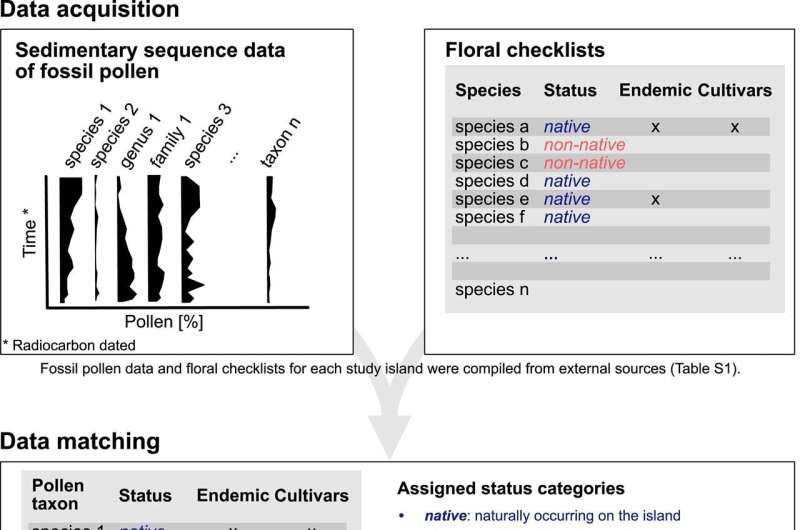Global study shows increasing spread of non-native plants on islands

A global study published in Ecological Letters shows with hitherto unmatched differentiation the extent to which non-native plants have spread to oceanic and coastal islands over the last 5,000 years.
Researchers at the University of Bayreuth and at universities and research institutes in Great Britain, Norway, Austria, Spain, Australia and New Zealand have compiled a dataset covering the vegetation of 29 islands. This was based on analyses of fossil pollen and the current state of research on the classification of plants as native or non-native.
The research has shown that the proportion of non-native plants has increased continuously over the last thousand years.
This trend has persisted until today. In detail, however, there are significant differences between the 29 islands, which are distributed over different climatic regions of the Pacific and Atlantic Oceans as well as in the Caribbean: The vegetation dynamics of the islands strongly depend on their human settlement histories, which began at different times and developed depending on specific geographical, economic and political factors.
Overall, however, it is true that humans have changed the vegetation of the islands primarily by introducing non-native species unknowingly or deliberately upon their arrival and in the course of further settlement.
“In our study, we were able to reconstruct these relationships over a very long period of several thousand years. Also, little was previously known in research about the increase in non-native species that occurred on some islands shortly before human settlement. However, with the help of analyses of fossil pollen, we were able to close this gap. This pollen was contained in sediments whose age can be reliably determined by radiocarbon dating in conjunction with age-depth models,” says the first author of the study, Anna Walentowitz from the University of Bayreuth.
The authors of the study have succeeded for the first time in quantifying changes in the vegetation dynamics of non-native plant species over the last 5,000 years: On average, the proportion of pollen from these plants on the islands studied was between one and six percent before their permanent settlement by humans, afterwards it was between five and 16 percent. On all islands, these percentages have increased up to the present, reaching averages of eight to 25 percent today.
The wide range of data gathered in the new study to gain insights into paleoecological trends over the past millennia complements, in many individual cases, earlier known censuses and documentation. The results make it clear that less was previously known about the extent and consequences of anthropogenic biodiversity changes on islands than was assumed in ecological research.
“Oceanic and coastal islands are microcosms in which we can observe exemplary changes in biodiversity in the Anthropocene with high accuracy over long periods of time. Therefore, research in this area should be intensified in the future. The results can help us to develop sustainable strategies for dealing with these changes—and possibly also for influencing them in a targeted manner,” says Anna Walentowitz, Ph.D. student and research associate at the Biogeography research group at the University of Bayreuth.
More information:
Anna Walentowitz et al, Long‐term trajectories of non‐native vegetation on islands globally, Ecology Letters (2023). DOI: 10.1111/ele.14196
Citation:
Global study shows increasing spread of non-native plants on islands (2023, April 26)
retrieved 26 April 2023
from https://phys.org/news/2023-04-global-non-native-islands.html
This document is subject to copyright. Apart from any fair dealing for the purpose of private study or research, no
part may be reproduced without the written permission. The content is provided for information purposes only.
For all the latest Science News Click Here
For the latest news and updates, follow us on Google News.

